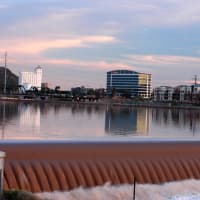AMWUA Blog
BY: Kathleen FerrisTempe Town Lake: How (And Why) Did They Do That?

Tempe Town Lake is a manmade lake set in a dry riverbed in the middle of the desert. The 261 acre urban lake is a surprise to newcomers and still a marvel to those who were here when it was first filled in 1999.
The lake is the centerpiece for a City of Tempe recreation area that hosts fireworks and Valley parties, team rowers and kayakers, anglers and sunbathers. The lake attracts 2.7 million people each year.
Economics
From 1997 through 2012, Tempe Town Lake generated more than $825 million for the city through special events, private and public development, and taxes. From 1985 through 2012, Tempe Town Lake cost $350 million to design, build and operate. The City of Tempe has contributed about 75 percent of that amount. Not a bad return on investment.
The water stopped flowing in this part of the Salt River over 100 years ago when dams were built upstream to store water for Valley farmers and later for homes and businesses. The empty riverbed became the Valley’s dump. Tempe Town Lake was part of a Valley-wide effort to control occasional, but damaging flooding in the riverbed and to turn the Salt Riverbed into an asset instead of a scar.
Phoenix has two restoration projects in the riverbed with similar goals: the 600-acre Rio Salado Habitat Restoration Area south of downtown and the 500-acre Tres Rios Wetlands at the far southwest edge of the city.
History
In the mid 1960s, Arizona State University students first began envisioning an ambitious plan for the empty riverbed. The students designed a series of locks and channels down Salt River that created an inland seaport. By 1974, the concept for the riverbed was tamed to 38-mile flood control channel and green belt with lakes and streams.
In 1987, a proposed countywide property tax to fund the green belt was defeated by voters, except in Tempe. The empty riverbed served as their city’s gateway and Tempe voters liked the idea of restoring water to the river and making adjacent land usable.
A decade later, Tempe was working with local and federal agencies and other partners to build a lake in the Salt River channel. Tempe Town Lake was filled in 1999 using four rubber dams that could be deflated when floodwater rushed down the riverbed.
Operations
It’s not easy digging a flood channel into an empty riverbed and creating a lake on top of it. Here are just a few of the secrets to building a lake in the desert.
- Water: Tempe Town Lake is mostly filled with water from the Colorado River and Upper Salt River. The lake also captures water from storm drains and rainwater runoff that rushes through Indian Bend Wash. Water from storm drains and the wash bring with it everything that is left in parks, parking lots, driveways, sidewalks and streets. Swimming is not permitted in the lake except for athletic events, such as triathlons. The city does additional water quality testing for these events and treats the water if required. The city controls midges and mosquitoes by stocking fish that eat the larva and uses chemical treatments to control algae.
- Evaporation: Evaporation is a force of nature when trying to manage water in the desert. Shallow lakes less than 6 or 7 feet deep, such as water features in parks and golf courses, lose 100 percent of their water to evaporation each year. Tempe Town Lake is between 5 and 15 feet deep and holds about 3,000 acre-feet of water. (One acre-foot is enough to serve 2.5 average Phoenix-area households for a year.) In 2013, the lake lost nearly 2,000 acre-feet of water to evaporation. That is 7-feet of water annually or 2/3 of the lake’s capacity.
- Seepage: Containment walls prevent water from sinking into the ground along the western section of Tempe Town Lake. Geology of the land under the eastern section of the lake made containment walls difficult to build. Instead, 10 seepage wells recover water that sinks into the ground and returns it to the lake. At least some of the 10 seepage wells are active every day and the amount of water they retrieve varies. In June, the wells retrieved between 9 acre-feet and 46 acre-feet of water a day. In total, the seepage wells recovered 472 acre-feet in June.
The Tempe Town Lake emptied abruptly in 2010 when one of its four rubber dams burst. It reopened that same year, and Tempe is now building steel hinged dams to replace the rubber dams.
Tempe Town Lake is surrounded by trails and is stocked with fish. It has a Splash Playground for kids and boat rentals. Perhaps it’s time for family day at the lake.
For 45 years, Arizona Municipal Water Users Association has worked to protect our member cities’ ability to provide assured, safe and sustainable water supplies to their communities. For more water information visit www.amwua.org.
